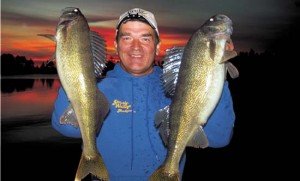Slip Bobbering Weed Walleyes
by Nathan Shore
 Giant walleyes prowl through weeds all summer long, yet they’re pretty safe from most fishermen. Sure, you can know they’re in there, but getting them out is a challenge.
Giant walleyes prowl through weeds all summer long, yet they’re pretty safe from most fishermen. Sure, you can know they’re in there, but getting them out is a challenge.
Few anglers know more about getting big walleyes out of the weeds long-time guide and author of “Master The Art of Slip Bobbering,” Greg Bohn. He’s likely netted more 10-pound weed-holding walleyes than any other guide in the country. For him, slip bobbering weed walleyes is an art form.
 Bohn says that successful slip bobbering weed walleyes begins with using the right equipment to deliver baits to the correct depth. Keeping the boat positioned and moving at the right speed also are critical.
Bohn says that successful slip bobbering weed walleyes begins with using the right equipment to deliver baits to the correct depth. Keeping the boat positioned and moving at the right speed also are critical.
“I want the boat 20 feet or so off the weedline at all times,” Bohn said, “and moving at less than 1 mph.”
Fishing the right weedbeds is the final piece of the puzzle. During summer, Bohn focuses on main-lake weedlines surrounding the deepest basins in the lake. Prime spots are weedbeds on main-lake points, offshore humps and mid-lake bars. He says that the spot-within-the-spot often is the area where weeds get closest to deep water.
“If you find one of those spots with some boulders nearby or a hard-bottom break in the weedline, you should be getting goose bumps,” Bohn said. “Those are trophy walleye spots in summer.”
Because these areas often are in open water, wind and waves can affect your ability to precisely present baits. Bohn combats the surface disturbance with a waggler-style float featuring long stems with the thickest part below the water line.
“I use Thill Wagglers when we’re anchored on windy days,” he added. “The wind can’t grab it and pull it off the spot.”
No matter what style float you use, a 9-foot float rod with a fast tip and a solid backbone is critical for line control and setting hooks. Bohn gives walleyes a choice between crawlers, leeches, or minnows.
“We slide our floats onto 10- to 15-pound braided lines tied to Thill Pro Series Slip Bobber Rigs for slip bobbering weed walleyes, which feature 18 inches of 10-pound mono with a swivel on one end and a small blade, faceted bead and either a Tru-Turn Hook or Lindy Bobber Bug Jig on the other end.”
Bohn uses the bladed jigs when drifting and the bare hook when anchored. The plain hooks give the bait more freedom to move around while the rig stays in the strike zone. To fish a weedline, Bohn first marks the edges with GPS icons. He slips into the wind with a Drift Sock tied to the bow for the ultimate in control over direction and speed.
“Rigs have to stay as vertical as possible,” Bohn said. “Slip-bobbers are most effective for slip bobbering weed walleyes when the bait is kept 1 to 3 feet off bottom.”
If the wind is substantial or he’s drifting at a faster pace, Bohn may replace his Bobber Rigs with jigs to anchor the baits in the strike zone. He goes as heavy as ¼-ounce, and on dark days or in stained water, he bulks-up the jig with Watsit Jigs or Fuzz-E-Grubs.
With the boat moving slowly and floats positioned along the outside edge of the weeds, Bohn lip hooks a minnow or nose-hooks a crawler so they move naturally through the water with less drag.
“Let the walleyes tell you what they want,” Bohn advises. “I always have crawlers, leeches and various species of minnows along. To start out, everybody baits up with something different until we zero-in on that preference.”
AWhen slip bobbering weed walleyes a spread and placement of bobbers around a drifting boat is called a “drift set.” Bohn wants all slip floats placed and spaced strategically from the edge of the weeds to 20 feet out on the flat, and far enough apart so people don’t tangle when a big fish is hooked. If he’s drifting with the wind along the edge of a weed flat, Bohn again uses drift socks to slow the boat down.
“We keep baits at the right depth and avoid snags by noting the highest points along any drift or weedline,” Bohn said. “We slide our Float Stops to a point on the line that will keep our jigs a foot above the shallowest spot on the drift.”
On a typical day, Bohn positions a float or two close to the back of the boat, within range of the transducer cone on the transom so he can spot walleyes approaching those rigs with sonar. The next pair of floats are placed 15 feet from the boat, and depending on how many clients are in the boat, the remainder will be staggered out to a distance of 30 feet.
“Most days you can’t see a float often enough when it’s beyond 30 feet in waves,” Bohn said. “But if all the bites are occurring on floats set farthest from the boat, it’s a sign that walleyes are spooked or in a finicky mood. Time to drop the anchor and quiet things down.”
Bohn has quite possibly caught more walleyes with slip floats than any man alive, and it’s just as much fun for him today as when he began guiding 40 years ago.
“When that float goes down, I still get excited,” he said. “When it goes down on the right spot-on the right weedline-goosebump city.”
“slip bobbering weed walleyes”